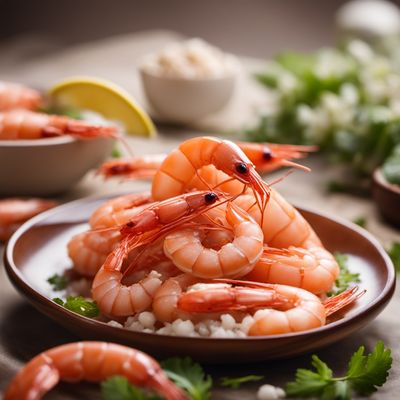
Ingredient
Krill, planktonic crustaceans
The Tiny Marvels of the Ocean: Unveiling the World of Krill
Krill are tiny, shrimp-like crustaceans that inhabit the world's oceans in vast numbers. They have a translucent appearance and measure around 1 to 2 centimeters in length. Krill have a delicate texture and a slightly sweet taste, often described as a cross between shrimp and crab. They are known for their high oil content, which gives them a rich and buttery flavor. Their small size makes them a versatile ingredient in various culinary preparations.
Origins and history
Krill have a long history dating back millions of years and are found in all major oceans. They are particularly abundant in the Southern Ocean surrounding Antarctica. Krill have been a vital part of the diet of marine animals, including whales, seals, and penguins, for centuries. In recent years, krill have gained attention as a sustainable food source due to their abundance and high nutritional value.
Nutritional information
Krill are a rich source of omega-3 fatty acids, which are essential for brain health and reducing inflammation. They also contain high levels of protein, vitamins (such as vitamin E), and minerals (such as iron and zinc). Additionally, krill are low in calories, making them a nutritious choice for those watching their weight.
Allergens
Krill may cause allergic reactions in individuals with shellfish allergies.
How to select
When selecting krill, look for fresh, frozen, or dried options. Fresh krill should have a translucent appearance and a mild, briny smell. Frozen or dried krill should be free from freezer burn or signs of moisture. Opt for sustainably sourced krill to support responsible fishing practices.
Storage recommendations
Fresh krill should be consumed immediately or stored in the refrigerator for up to two days. Frozen krill can be kept in the freezer for several months. Dried krill should be stored in an airtight container in a cool, dry place to maintain their quality.
How to produce
Krill are primarily harvested from the ocean using specialized nets and trawlers. As an amateur, it is not feasible to produce krill on your own due to the complex nature of their habitat and the equipment required for harvesting.
Preparation tips
Krill can be prepared in various ways, including boiling, grilling, sautéing, or adding them to soups and stews. To remove the shells, gently squeeze the tail and pull it away from the body. Krill can be marinated with herbs and spices to enhance their flavor. They are also commonly used as a topping for salads or incorporated into seafood dishes.
Substitutions
N/A (There are no suitable substitutions for krill due to their unique flavor and nutritional profile.)
Culinary uses
Krill are commonly used in seafood dishes, such as stir-fries, pasta, risottos, and sushi. They can also be used as a garnish for salads or incorporated into sauces and dips for added flavor and texture.
Availability
Krill are commonly available in regions with access to the ocean, including coastal areas of North America, Europe, and Asia. They are also cultivated and harvested in the Southern Ocean surrounding Antarctica.
More ingredients from this category

King crabs, squat-lobsters
Majestic Crustaceans: King Crabs and Squat-Lobsters

Lobsters, spiny-rock lobster
Spiny-Rock Lobster: The Delicacy from the Sea

Crabs, sea-spiders
Delicacies from the Deep: Exploring the World of Crabs and Sea-Spiders

Miscellaneous marine crustaceans
Oceanic Delicacies

Freshwater crustaceans
Delicate Aquatic Gems

Shrimps and prawns
Delicious Crustaceans